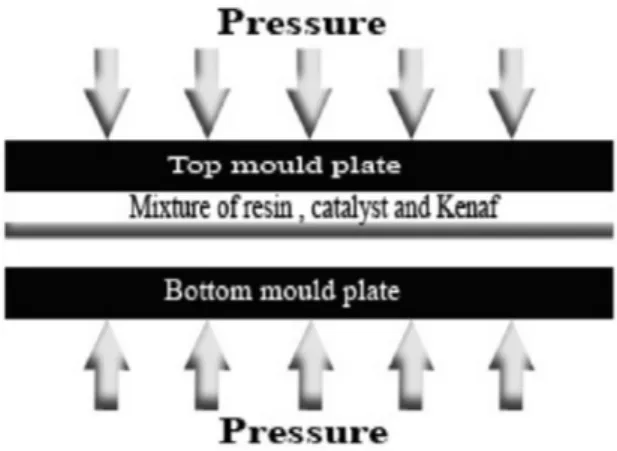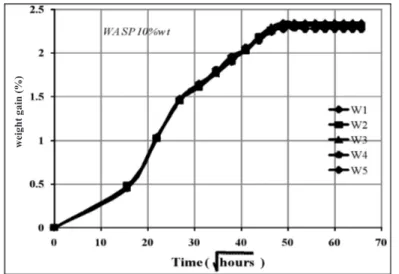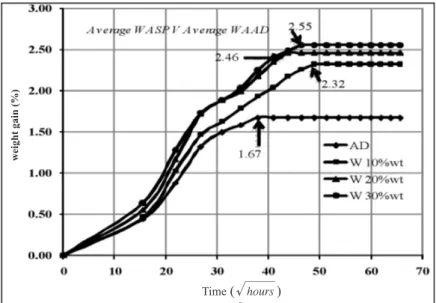Received: 26 November 2009
Water Absorption Behaviour of Kenaf Reinforced Unsaturated Polyester
Composites and Its Influence on Their Mechanical Properties
Abdalla A. Ab. Rashdi1, Mohd Sapuan Salit1*, Khalina Abdan2 and Megat Mohamad Hamdan Megat3
1Department of Mechanical and Manufacturing Engineering,
2Department of Biological and Agricultural Engineering, Faculty of Engineering,
Universiti Putra Malaysia, 43400 UPM, Serdang, Selangor, Malaysia
3Faculty of Engineering, National Defence University of Malaysia,
Kem Sungai Besi, 57000 Kuala Lumpur, Malaysia
*E-mail: sapuan@eng.upm.edu.my
ABSTRACT
Fibre reinforced composites have gained use in a variety of applications. The performances of these composites may suffer when the material is exposed to adverse environments for a long period of time. Kenaf fibre reinforced unsaturated polyester composites were subjected to water immersion tests in order to study the effects of water absorption on the mechanical properties. Composites specimens containing (10%, 20%, and 30%) weight percentages of fibre were prepared. Water absorption tests were conducted by immersing these specimens in a distilled water bath at 25oC for four months. The tensile properties of the specimens immersed in water were evaluated and compared with the dry composite specimens. A decrease in the tensile properties of the composites was demonstrated, indicating a great loss in the mechanical properties of the water-saturated samples compared to the dry samples. The percentage of moisture uptake was also increased as the percentage of the fibre weight increased due to the high cellulose content. The water absorption pattern of these composites was found to follow the Fickian behaviour.
Keywords: Polyester matrix composite, natural fibre, kenaf, mechanical properties INTRODUCTION
Natural fibres unsaturated polyester composites have become increasingly used in many applications not only because they are environmentally friendly, but also because of their various desirable
properties which include high specific strength and high specific stiffness. The use of natural fibres and unsaturated polyester matrix is highly beneficial because the strength and toughness of
the resulting composites are greater than those of the unreinforced plastics. Moreover, cellulose-based natural fibres are strong, light, cheap, abundant, and renewable. In recent years, natural fibres
reinforced unsaturated polyester materials are used in many applications such as automotive, sporting goods, marine, electrical, industrial, construction, and household appliances (Wallenberger and
Weston, 2004). A number of investigations have been conducted on several types of natural fibres
such as kenaf, hemp, flax, bamboo, and jute to study the effects of these fibres on the mechanical properties of composite materials (Satyanarayana et al., 1990; Mansur and Aziz, 1983).
Kenaf (Hibiscus cannabinus, L. family Malvaceae) is an herbaceous annual plant. It is a warm-season annual row crop. Kenaf has a single, straight, and unbranched stem consisting of two parts, namely an outer fibrous bark and an inner woody core. The attractive features of kenaf grow quickly, rising to heights of 4-5m in a 4-5 month growing season and 25-35 mm in diameter (Nimmo,
2002), with high biomass output, broad growth area, strong adaptability to environment, and low cost in cultivated condition. Furthermore, the kenaf fibre composites have excellent strength and
renewability. Kenaf has a bast fibre which contains 75% cellulose and 15% lignin, and it offers the advantages of being biodegradable and environmentally safe (Karnani, 1996). In addition, natural plant fibre reinforced unsaturated polyester composite also have some disadvantages such as the
incompatibility between the hydrophilic fibres and hydrophobic thermoplastic, as well as thermoset matrices requiring appropriate treatments to enhance the adhesion between the fibre and the matrix (Gassan and Cutowski, 2000; Dhakal et al., 2007).
All polymer composites absorb moisture in humid atmosphere and when they are immersed in
water. The effect of moisture absorption leads to the degradation of fibre-matrix interface region which thus creates poor stress transfer efficiencies resulting in a reduction of mechanical properties
(Yang et al., 1996). Meanwhile, among the main concerns for the use of natural fibre reinforced
composite materials are their susceptibility to moisture absorption and the effects on the physical and mechanical properties (Thwe and Kin, 2002). Therefore, it is important that the problems are investigated so that natural fibre could be considered as a viable reinforcement in the composite materials. Aziz et al. (2005) studied kenaf unsaturated polyester composites and observed that their moisture absorption indicated that polyester composites gave the most superior bonding and
adhesion, apart from higher storage modulus.
ExPERIMENTAL DESIGN
Materials
Long fibre kenaf were used for the fibre reinforcements. The matrix material used in this study was
based on the unsaturated polyester resin trade name Reservol P9509 which was supplied by Revertex (Malaysia) Sdn. Bhd. This type of resin is rigid, and with low reactivity, thixotropic general purpose orthophthalic. The matrix was mixed with curing catalyst, methyl ethyl ketone peroxide (MEKP) at a concentration of 0.01 w/w (weight ratio) of the matrix for curing. Unsaturated polyester has many advantages compared to other thermosetting resins including room temperature and low pressure
moulding capabilities which make it particularly valuable for large component manufacturing at a relatively low cost (El-Sayed et al., 1995).
Methods
A combination of hand lay-up and compression moulding method was used to prepare kenaf
unsaturated polyester composites samples. Long kenaf fibre was first dried at 100oC to remove
stored moisture in an oven. A measured quantity of unsaturated polyester resin was mixed with
curing catalyst (MEKP) at a concentration of 0.01 w/w of the matrix for curing was poured on the kenaf fibre, and placed in a mould. The mould was closed and kept under pressure of 5 bar at a
temperature of 50oC for about 1h. The mould was then opened and the composite was removed
from the press. The mechanical tensile test and water absorption evaluation test samples were cut
in the sizes of 250 mm x 15mm x 2 mm and 62mm x 62mm x 1mm, respectively. The schematic
view of a mould press used to consolidate the composite panel is shown in Fig. 1.
The water absorption test was carried out as described by ASTM D570. For the purpose
of water absorption study, the specimens with a dimension of (62 x 62 x 1) mm3 marked (AD)
were immersed in distilled water for four months. The tensile test specimens of dimensions (250 x 15 x 2) mm3 marked (W) were immersed in the same distilled water for the same period of time, and the aim was to study the effect of water absorption in mechanical tensile properties
of composites (Fig. 2). The samples were collected every 10 days and dried to a constant weight at 40oC. The percent of the moisture content or percentage weight gain, M
i is calculated using following equation: M W W W 100 i b i b =b - l Where
Mi = Percentage weight gain, g
Wi = Weight of the specimen at time (t)
Wi = Baseline mass (oven dry specimen mass), g
Weight-gain was plotted versus the square root of time for all the samples in order to investigate
the absorption behaviour of the samples. Fifteen tensile stress samples were used with weight percentages of fibre (10%wt, 20%wt, and 30%wt) to study the tensile properties of the composites.
The tensile strength and modulus of kenaf fibre reinforced unsaturated polyester composite after
water absorption were carried out using the Instron 5569 Universal Electromechanical Testing System with 50 kN loading capacity
,
and with a cross-head speed of 2 mm/min. The clamping procedure was performed carefully to ensure that the specimen was aligned with the loading axis.Fig. 1: Schematic of the composite consolidation
Fig. 2: Schematic view of the (a) water absorption (AD) and (b) tensile composite samples
RESULTS AND DISCUSSION
Water Absorption of Immersed Composites
Fig. 3 shows the weight gain due to the moisture uptake of water absorption samples AD for four
months. It is observed that the samples had a significant and sharp linear increase in their moisture absorption and reached their saturation state with the maximum moisture content of 1.7% after 1440 h, following the Fickian diffusion process. Nevertheless, there was not much change observed in the weight. This status can be described by considering the water uptake attributes of kenaf fibre (Dhakal et al., 2007).
Fig. 3: Weight-gain of AD specimens versus the square root of immersed time
Fig. 4: Weight-gain of 30%wt specimens versus the square root of immersed time
weight gain (%)
Fig. 4 shows the behaviour of the 30%wt samples after they had been immersed in water for four months. From the process of weight gain due to moisture uptake, it is observed that the samples
had a sharp linear increase in their moisture absorption and reached their saturation state with the
maximum moisture content of 2.55% after 2160 h (90 days) with linear initial gain. The 20%wt
samples, shown in Fig. 5, reached their saturated state after a linear increasing region at about
1920h (80 days) of immersion, whereas the moisture content at equilibrium was about 2.46%. In the case of 10%wt samples, the initial linear gain and these samples reached their saturation state with maximum moisture content of 2.32% about 2400 hours (100 days) after immersion (Fig. 6).
Fig. 5: Weight-gain of 20%wt specimens versus the square root of immersed time
Fig. 6: Weight-gain of 10%wt specimens versus the square root of immersed time
weight gain (%)
Fig. 7 shows the comparison in the average weight gain between the 10%wt, 20%wt, 30%wt, and the AD specimens. It is observed that the samples with 30%wt gained more moisture and took longer time to reach the maximum moisture content of 2.55% after 2160 h (90 days) as compared with other samples. The high fibre content in the samples enables more water penetration into the interface through the micro cracks induced by the swelling of fibres that created swelling stresses leading to composite failure (Bismarck et al., 2004). The moisture gain for the AD samples was faster as it reached the maximum after 1440 h (60 days). The difference in thickness might lead to a much faster moisture gain for the AD samples.
Fig. 7: Comparison of average weight gain between the AD and tensile test samples (W) versus the square root of immersed time
Effects of Moisture Absorption on the Mechanical Properties of Composites
Most specimens reached their saturation state with the maximum moisture content in about 1920h-2400h. Nonetheless, no significant mass loss was observed. Fig. 8 shows the tensile stresses results
versus the weight percentage of fibre content for both the dry and immersed samples. It was observed that tensile stress was high as the fibre content increased for the dry specimens unlike the immersed specimens where the tensile stress was found to decrease. The same observation was obtained for the other specimen groups (20%wt and 10%wt). The stress-strain curves are linear up to the point of failure for all the specimens. As for the stress at the maximum load, the immersed specimens
values were somewhat reduced after water absorption.
weight gain (%)
Fig. 8: Tensile stresses versus the weight percentage of the fibre
content for the dry and immersed samples
Fig. 9 shows that due to the moisture uptake, the mechanical properties decreased with the
increase of fibre content. It was observed that the 10%wt sample reached the maximum values of Young’s modulus (117.7 MPa) and the tensile properties of 120 MPa, whereas the Young’s modulus was 114.3 MPa and the tensile stress was 106.8 MPa for the 20%wt samples. However, it is noticed that the ultimate tensile stress is low (97.9 MPa) compared to other samples for the 30%wt reinforced samples. This could be due to the high amounts of water absorption that led to decrease in the mechanical properties for composite with higher fibre content.
Fig. 9: Average stress strain curve of the tensile stress samples
Tensile str
ength (M)a)
weight percentage of fibre content
Tensile str
ength (M)a)
CONCLUSIONS
The effects of water absorption on the mechanical properties of kenaf fibre reinforced unsaturated polyester composite were studied using water immersion samples. It is shown that the moisture uptake increases with the increase in the percentage of the fibre content. The water absorption pattern of these composites was found to follow the Fickian behaviour. Meanwhile, increasing the weight percentage of the fibre content was found to the increase the tensile properties of the composites for the dry specimen, whereas increasing the weight percentage of fibre content could
lead to a decrease in the tensile properties of the composites for the immersed specimen. ACKNOWLEDGEMENTS
The authors wish to thank Universiti Putra Malaysia for the financial support through Research University Grant Scheme (RUGS) in acquiring the polymer materials.
REFERENCES
Aziz, S.H., Ansell, M.P., Clarke, S.J. and Panteny, S.R. (2005). Modified polyester resins for natural fibre composites. Composites Science and Technology, 65, 525-535.
Bismarck, A., Aranberri-Askargorta, I., Springer, J., Wielage, T.L.B., Ilja, A.S. and Limbach, H. H. (2004). Surface characterization of flax, hemp and cellulose fibers: Surface properties and the water uptake behavior. Polymer Composites, 23, 872-894.
Dhakal, H.N., Zhang, Z.Y. and Richarson, M.O.W. (2007). Effect of water absorption on the mechanical properties of hemp fibre reinforced unsaturated polyester composites. Composites Science and Technology, 67, 1674-1683.
El-Sayed, A.A., El-Sherbiny, M.G., Abo-El-Ezz, A.S. and Aggag, G.A. (1995). Friction and wear properties of polymeric composite materials for bearing applications. Wear, 184, 45-53.
Gassan, J. and Cutoswski, V.S. (2000). Effect of corona discharge and UV treatment on the properties of jute-fibre epoxy composite. Compost Science Technology, 60, 2857-2863.
Karnani, R. (1996). Kenaf-reinforced polypropylene composites. Master Thesis, Michigan State University. Mansur, M.A. and Aziz, M.A. (1983). Study of bamboo-mesh reinforced cement composites. International
Cement Composites and Lightweight Concrete,5, 165–171.
Nimmo Bert.(November, 2002). Kenaf fibers. Presentation of the 5th Annual Conference of the American Kenaf Society, Memphis, TN., 7-9.
Satyanarayana, K. G., Sukumaran, P.S.M. andC.P. & Pillai, S.G.K. (1990). Natural fiber–polymer composites. Journal of Cement and Concrete Composites, 12, 117–136.
Thwe,M.M. and Kin, L. (2002). Effects of environmental ageing on the mechanical properties of bamboo-glass fibre reinforced polymer matrix hybrid composites. Composites Part A, 33, 43-52.
Wallenberger, F. T. and Weston, N. (2004). Natural Fibers, Plastics and Composites Natural. Materials Source Book from C.H.I.P.S. Texas.
Yang, G.C., Zeng, H.M., L.J., Jian, N.B. and Wb, Z. (1996). Relation of modification and tensile properties of sisal fibre. Acta Scientiarum Naturalium Universitatis Sunyatseni, 35, 53-57.




